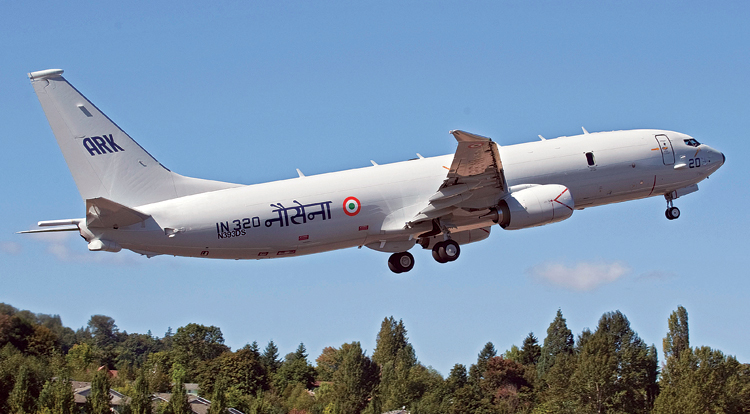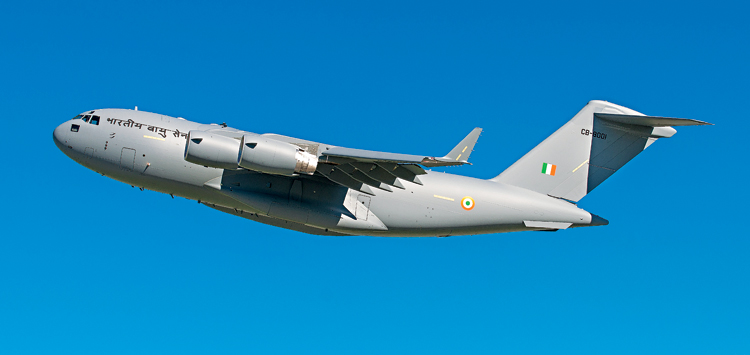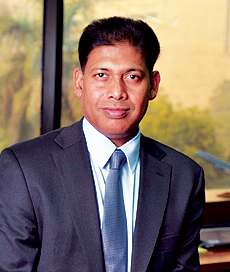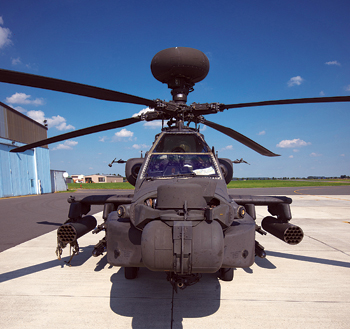INDIAN ARMED FORCES CHIEFS ON OUR RELENTLESS AND FOCUSED PUBLISHING EFFORTS

The insightful articles, inspiring narrations and analytical perspectives presented by the Editorial Team, establish an alluring connect with the reader. My compliments and best wishes to SP Guide Publications.

"Over the past 60 years, the growth of SP Guide Publications has mirrored the rising stature of Indian Navy. Its well-researched and informative magazines on Defence and Aerospace sector have served to shape an educated opinion of our military personnel, policy makers and the public alike. I wish SP's Publication team continued success, fair winds and following seas in all future endeavour!"

Since, its inception in 1964, SP Guide Publications has consistently demonstrated commitment to high-quality journalism in the aerospace and defence sectors, earning a well-deserved reputation as Asia's largest media house in this domain. I wish SP Guide Publications continued success in its pursuit of excellence.
Boeing: & Still Counting...
Boeing has emerged as the leading company from US on the front of Indo-US defence cooperation and partnership. The company looks forward to take up the relationship also being termed as strategic partnership to next levels.

Boeing & India
| Date of Contract | Product | Arm of Indian Armed Forces | Qty | Contract Value |
|---|---|---|---|---|
| *August 17, 2017 | AH-64E Apache | Army | 6 | $0.651 billion |
| July 27, 2016 | P-8I | Navy | 4 | $1.0 billion |
| September 22, 2015 | AH-64E Apache CH-47F Chinook | Air Force Air Force | 22 15 | $3.0 billion |
| June 6, 2011 | C-17 | Air Force | 10 | $4.1 billion |
| January 6, 2009 | P-8I | Navy | 8 | $2.1 billion |
| October 27, 2005 | BBJ | Air Force | 3 | $0.161 billion |
| TOTAL | $11.01 billion | |||
| Harpoon Missile Systems has also been supplied for P-8I and Jaguars (Navy and Air Force respectively), being a lilttle sensitive item, we have not included any data. | ||||
The news in the media in the third week of August this year that the Ministry of Defence (MoD) had cleared a proposal by the Indian Army for the acquisition of six AH-64E Apache attack helicopters from Boeing Defense and Space of the United States (US), not only brought cheer to the service especially in the context of the escalating tension on the Doklam plateau as also elsewhere along the Sino-Indian border, it also marked a step forward in the cooperation between India and the US in the regime of defence.
Even though the number cleared recently by the MoD is not significantly large; nevertheless it is a welcome step. The Indian Army has projected an initial requirement of 39 of these platforms. Clearance for six AH-64E Apache attack helicopters, therefore is most likely the first installment and nod by the MoD for additional attack helicopters for the Indian Army ought to follow even beyond the initial projection. Hopefully, contract with Boeing for six Apaches worth over 4100 crore should be concluded in the near future.
Boeing Defense, Space and Security
Today, Boeing is the largest aerospace company in the world and apart from it being the leading manufacturer of commercial jetliners, its Defense, Space and Security wing, BDS for short and formerly known as Boeing Integrated Defense Systems, commands a dominating position in the regime of defence, space and security systems. Products from BDS include military aircraft, satellites, weapons, electronic and defence systems, launch systems, advanced information and communication systems, training and performance-based logistics. Boeing has had a long tradition of leadership in the field of aerospace and the company continues to expand its product line and services to meet emerging customer needs.

Although the relationship between India and Boeing began around seven decades ago, it was confined to the regime of civil aviation. In an effort to modernise the Indian Air Force (IAF), the government initially looked at Western sources for military aircraft and weapon systems. In the 1950s, the IAF procured the Vampire, Hunter and the Folland Gnat jet fighters from the United Kingdom (UK). From Dassault Aviation of France came the Ouragan (renamed Toofani by the IAF) and the Mystere IV A jet fighters, all through direct deals with the respective governments. The IAF also received light utility helicopters from Aerospatiale of France. The US transferred a fleet of C-119 Fairchild Packet military transport aircraft, but did not supply combat aircraft. Owing to political realignments and ensuing compulsions, India began to lean towards the then Soviet Union and as a result, the nation remained tethered to the this new source for most of military hardware.
THE FLEET OF C-17 GLOBEMASTER III AIRCRAFT WITH THE IAF REPRESENTS INDIA’S CAPABILITY OF RAPID DEPLOYMENT AND EXTENDED REACH OF ITS STRATEGIC AIRLIFT CAPABILITY
However, with the collapse of the Soviet Union and the emergence of a unipolar world, the IAF now had the opportunity to explore options with aerospace and defence majors in the US, the UK, the European Union, France, Italy and Israel. Thus in the quest for military aircraft and weapon systems built with modern and more advanced technologies, India’s interaction with Boeing which thus far had been restricted largely to the domain of civil aviation, began to extend beyond it, albeit somewhat slowly, into the regime of military platforms and hardware.
Fixed Wing Aircraft
Although BDS was prepared to offer a wide range of solutions to meet with India’s requirements in the defence sector, the first baby steps were taken in the period 2008-09 when BDS delivered three Boeing Business Jets for Air Headquarters Communication Squadron for use by VVIPs. Moving on from there, the Government of India signed a contract on January 1, 2009 to purchase eight P-8I long-range, maritime reconnaissance and anti-submarine aircraft from Boeing for the Indian Navy. The P-8I is based on the next-generation Boeing 737 commercial jetliner from the US aerospace major and a variant of the P-8A Poseidon operated by the US Navy. This platform provides the Indian Navy the capability to carry out full range of maritime surveillance and patrol missions. The P-8I incorporates not only India-unique design features, but also India-built subsystems that are tailored to the country’s maritime patrol requirements. The first P-8I aircraft arrived on schedule in May 2013 and the remaining seven aircraft were delivered on schedule by 2015. Quite satisfied with the capabilities and performance of the fleet of P8I, in July 2016, the Indian Navy has placed orders for another four of these platforms.

In June 2011, the Indian MoD finalised an agreement with the US government for the procurement of ten Boeing C-17 Globemaster III strategic airlift aircraft through their Foreign Military Sales (FMS) programme. The deal valued at around 18,000 crore has been the largest defence contract signed by India with the US in the defence sector so far. The first C-17 arrived in India in June 2013 and all 10 airlifters were delivered to the Indian Air Force by 2015. Today, the fleet of C-17 Globemaster III aircraft with the IAF represents India’s capability of rapid deployment and extended reach of its strategic airlift capability. There was a provision in the contract with Boeing for another six C-17 aircraft. However, on account of inordinate delay on the part of the Government of India in the decision on the subject, Boeing has shut down its production line and is unable to meet with this requirement. India is now likely to get one more C-17 that is currently available with Boeing.
Rotary Wing Platforms
In September 2015, the Government of India, cleared the purchase of 22 AH-64 Apache attack helicopters and 15 CH-47F Chinook heavy lift helicopters for the IAF. The contract with Boeing valued at around $3.0 billion was the single biggest defence contract signed in the first 16 months of the NDA government. The contract has an option for follow-on orders for 11 more Apaches and four more Chinook helicopters. The deal for Apache is in two parts – one through Direct Commercial Sale (DCS) contract with Boeing for the attack helicopter, while the other is through FMS agreement with the US Government for weapons, radars and electronic warfare equipment. The Chinook is being acquired as a DCS deal as no weapons are involved. But what is of greater significance to the Indian aerospace industry in the defence sector is the announcement by Boeing made in October 2015 about the company’s plan to manufacture airframe components in India for both the platforms, in collaboration with the aerospace industry in the private sector. Boeing also has announced their plans to assemble the two helicopter types in India. These moves will help Boeing consolidate the company’s position in India and provide for not only the Indian defence market but accessto the global market as well.

Combat Aircraft for the IAF
In the regime of fixed wing military platforms, Boeing had suffered a minor setback when its FA/18 Super Hornet twin-engine combat aircraft was fielded in response to the tender for 126 medium multi-role combat aircraft (MMRCA) for the IAF floated by the Government of India. While the Super Hornet lost the race against the Rafale from Dassault of France, the tender itself was finally cancelled leaving the IAF with serious deficiency of aircraft in its combat fleet. Boeing should be back again on the Indian scene by fielding the F/A-18 Super Hornet against the requirement of 57 carrier-borne combat aircraft for the Indian Navy projected in January this year. As per pronouncements made by the erstwhile Minister of Defence Manohar Parrikar, India would look at inducting twin-engine fighter aircraft for the IAF sometime in the future. Boeing ought to be prepared to field the latest version of the Super Hornet or its successor as and when the tender for a twin-engine fighter is floated to meet the requirements of the IAF which is becoming increasingly urgent by the day.
Research and Technology Partnership
Apart from aircraft, Boeing has been working behind the scene in other fields as well. On March 31, 2009, Boeing established its Research and Technology Centre-India at Bengaluru, marking a major milestone for Boeing’s aerospace research and technology activities in India. The centre is the focal point for all technology activities in India and collaborates with many Indian R&D organisations, including government agencies, universities and the private sector. It also works with strategic partners to develop high-end technology solutions, particularly in the areas of materials, analysis methods, manufacturing and networks. It is one of five Boeing advanced research centres outside the US, the others being in Australia, China and Europe.
Opportunities Ahead
With the status of India being upgraded by the US Government to that of a Strategic Partner and the IAF badly in need of modernisation especially of its combat fleet, opportunities for Boeing will indeed be lucrative.
Quick Chat with Boeing’s Pratyush Kumar

SP’s Aviation posed a set of quick queries to Pratyush Kumar, President, Boeing India in a follow up to the latest deal of six Apache for the Indian Army. He outlined the details as under:
SP’s Aviation (SP’s): How will the Apaches benefit Indian Army?
Pratyush Kumar (Pratyush): The AH-64 Apache is the most capable multi-role combat helicopter, combining performance and lethality with more affordable and efficient maintenance. With India’s 10,907 km-long border that runs through hard and varied terrain, the AH-64E Apache can provide direct and accurate close air support for ground troops and antitank role to destroy enemy armor. The Apache AH-64E for the Indian Army will have the latest technology insertions that make it a lethal attack helicopter.
The Apache is the only available combat helicopter featuring a spectrum of capabilities to meet virtually any of the Indian Army’s mission requirements. The Apache, with its proven all-terrain mastery, is capable of giving more teeth to India’s military might. It is uniquely suited to meet the commander’s needs, including reconnaissance, security, peacekeeping operations, and lethal attack — in both land and littoral environments — all without reconfiguration.
Boeing welcomes the opportunity to support the Indian Army on their requirements. With this development, we look forward to supporting all three Indian defense forces — the Air Force, Navy and now the Army. It’s noteworthy that under Prime Minister Modi’s ‘Make in India’ initiative, AH-64 Apache fuselages and other aero structures are being manufactured at the Tata Boeing Aerospace joint venture facility in Hyderabad.
SP’s: What all capabilities will come with each machine for the Army?
Pratyush: Please contact the MoD for this.
SP’s: What kind of edge Apaches will give to Indian Army versus the armies in the neighborhood operating different types?
Pratyush: The Apache’s application range is unmatched and ranges across spectrum of conflict. It has been used time and again by the US Army as well as international customers for military and training operations to peace enforcement, humanitarian relief, disaster relief, national defense and counter special operations forces.
The Apache represents the best of high-performing technologies that will boost the Indian Army’s combat capabilities.
The improved drive system features a new split-torque face gear transmission that increases power capability to 3,400 shaft horsepower. The new composite main rotor blade accommodates the power increase, resulting in improved aircraft performance with increased payload.

The aircraft capabilities features increased digitisation, the joint tactical radio system, enhanced engines and drive systems, capability to control UAVs and new composite rotor blade. The new blades, which successfully completed flight testing in May 2004, helps increase the Apache’s cruise speed, climb rate and payload capability. Apache has a strong shell made of composite fibres to protect the pilots from bullets.
Integrating the T700-GE-701D engine with the enhanced digital electronic control unit and other drive system technologies results in an increase in hover ceiling altitude at greater gross weight on a 95-degree Fahrenheit day. The twin-engine tandem seat Apache is operated by two pilots, and can execute an attack within 30 seconds of an alert.
The Apache can be equipped with air-to-air missiles and the advanced precision kill weapon system rockets. The Longbow Apache carries the combination of armaments chosen for the particular mission. In the close support role, the helicopter carries 16 Hellfire missiles on four four-rail launchers and four air-to-air missiles. The Longbow Apache’s radar dome is unmasked for a single radar scan and then re-masked.
SP’s: What all roles these version of Apaches can play?
Pratyush: The Apache is the only available combat helicopter with a spectrum of capabilities for virtually any mission requirement. It is uniquely suited to meet the commander’s needs, including reconnaissance, security, peacekeeping operations, and lethal attack — in both land and littoral environments—all without reconfiguration.





